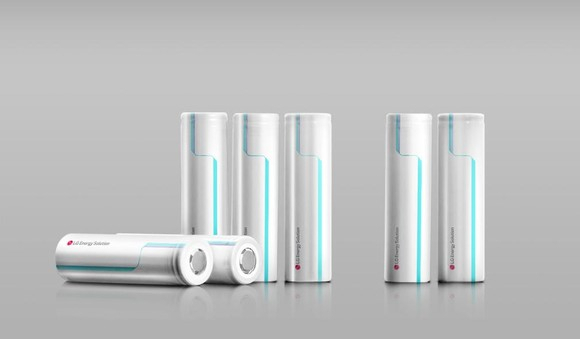 |
LG Energy Solution’s cylindrical batteries (LG Energy Solution) |
Cylindrical 4680 batteries, named for their 46-millimeter diameter and 80-millimeter height, are hailed as a pivotal advanced battery technology in electric vehicles due to enhanced energy storage capacity and power output. Tesla, a trailblazer in the EV industry, gained acclaim with its affordable electric vehicles powered by these cost-effective small batteries, comparable in size to the AA batteries used in handheld devices.
To produce bigger cylindrical cells that allow higher productivity and greater stability in battery management, Tesla threw its hat into the ring to mass produce 4680 batteries in 2020. But amid delays at the EV powerhouse, the initial enthusiasm has waned, with rumors swirling that Elon Musk might have scrapped the whole plan due to high production costs and poor yield optimization.
Tesla’s setback has become a boon for LG Energy Solution, which industry insiders say has been recruited to step in to fill the gap. LG is South Korea’s top battery maker but a latecomer in the 46 series. The company is now ready to start producing the batteries at its Korean plant in December this year, with US production set for 2026. The first batch of the batteries is expected to be supplied to Tesla.
According to industry sources, LG also signed a multi-billion dollar deal with Mercedes-Benz to supply larger 46-series cells, possibly 90 or 95 millimeters in height, for over 10 years starting in 2028.
Crosstown rivalry
It might seem LG Energy Solution took the initiative to launch the high-tech batteries. But its crosstown rival Samsung SDI announced its own development plan first in 2021.
Last year, Samsung made public that it would supply “cylindrical and prismatic cells” to US auto giant General Motors through a joint venture. But in August this year, the plan was downsized to “prismatic batteries only” due to GM’s scaling down of its electrification targets and uncertainty about the launch of EVs running on 46-series batteries, according to a source familiar with the matter.
Reports also indicated that Samsung SDI’s expansion of facilities for cylindrical cells at its Hungarian plant also faced backlash from local NGOs over environmental concerns. A Samsung spokesperson said the company was cleared of pollution allegations but denied the expansion plan at the European plant. "The company plans to produce cylindrical batteries in Korea and Malaysia," the official said.
Samsung aims to complete preparations for mass production of 46-series batteries for EVs by the end of this year. In the interim, it said it will focus on micro-mobility applications such as e-bikes and e-scooters next year.
Strategic betting
Industry watchers say Samsung’s risk-averse approach has led to it handing over the first-mover title in the high-performance battery tech to LG.
“The technology gap between the two companies is relatively small. Rather, it comes from different growth strategies. Samsung SDI is focusing on the high-tech all-solid-state batteries that could certainly boast its ‘super gap’ technology, while LG Energy Solution accelerates the launch of market-ready products,” said Yang Min-ho, an energy engineering professor at Dankuk University.
“Due to the overheated EV battery market, (I believe) Samsung is taking a conservative stance to target the less competitive micro-mobility sector. For Southeast Asian countries, which have the world’s highest two-wheeler penetration rate, e-bikes are a more realistic tool for achieving net zero.”
Echoing Yang’s view, Lee Ho-geun, a car engineering professor at Daeduk University, said, “Samsung SDI has little incentive to set up mass production facilities for 46-series cylindrical batteries when its major clients, including GM and BMW, have delayed the application of the new form factor. In contrast, LG’s existing business ties with Tesla spurred it to fast-track production of these cells.”
Lee also highlighted LG Energy Solution’s bold decision to invest heavily in a new manufacturing plant in Arizona, even before securing orders from carmakers, underscoring the differing investment strategies of the two companies. Samsung’s careful and measured approach helped it reduce operating losses in recent months amid slowing EV sales, while LG’s profits were almost cut in half.
Battery cost breakthrough
LG’s mega-sized deals with Tesla and Mercedes-Benz mean that it has met strict qualifications, especially pricing competitiveness, experts say.
“I believe LG was able to woo the two auto giants by securing high-quality cathode materials at lower prices -- a key factor in reducing the manufacturing costs of EVs,” said Yang. “In fact, cathode materials account for 51 percent of total battery costs. While automakers are trimming their electrification targets, cutting battery costs is likely a top priority.”
LG is expected to pioneer a cost-cutting, game-changing technology called the “dry-coating process” for cathode production. Compared to the conventional wet-coating process, this method does not require chemical solvents or complex drying steps, making it less expensive and more eco-friendly at the same time.
“The dry-coating process is reported to reduce facility setup costs by 30 percent (compared to wet-coating),” said Lee. “With further competitive pricing, LG could secure an upper hand in winning more clients in the future."







